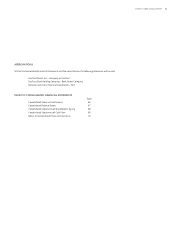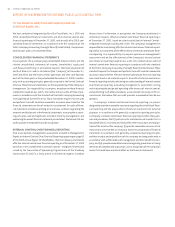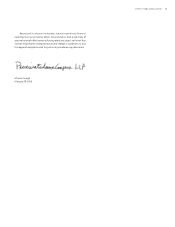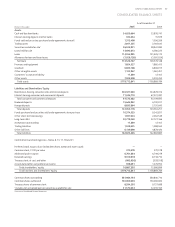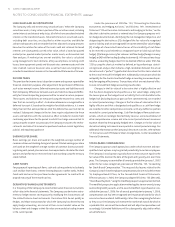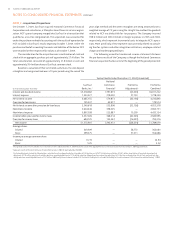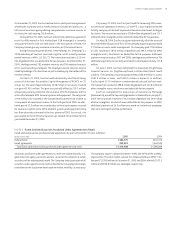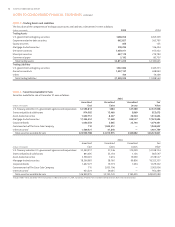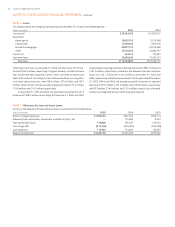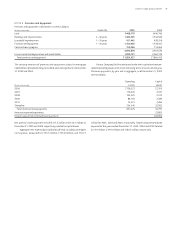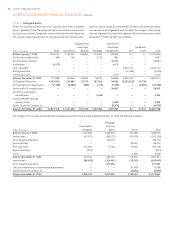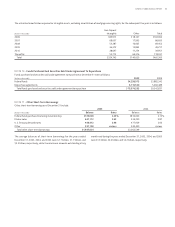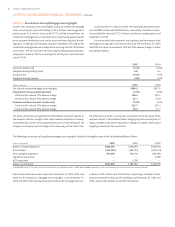SunTrust 2005 Annual Report Download - page 74
Download and view the complete annual report
Please find page 74 of the 2005 SunTrust annual report below. You can navigate through the pages in the report by either clicking on the pages listed below, or by using the keyword search tool below to find specific information within the annual report.SUNTRUST ANNUAL REPORT72
LOAN SALES AND SECURITIZATIONS
The Company sells and at times may securitize loans. When the Company
securitizes assets, it may retain a portion of the securities issued, including
senior interests and interest-only strips, all of which are considered retained
interests in the transferred assets. Retained interests in securitized assets,
including debt securities, are classified as either securities available for
sale or trading assets and are recorded at their allocated carrying amounts
based on the relative fair value of the assets sold and retained. Retained
interests are subsequently carried at fair value, which is based on quoted
market prices, quoted market prices for similar assets, or discounted cash
flow analyses. If market prices are not available, fair value is calculated
using management’s best estimates of key assumptions, including credit
losses, loan repayment speeds and discount rates commensurate with the
risks involved. Gains or losses on sales as well as future servicing fees are
recorded in noninterest income in the Consolidated Statements of Income.
INCOME TAXES
The provision for income taxes is based on income and expense reported for
financial statement purposes after adjustment for permanent differences
such as tax-exempt income. Deferred income tax assets and liabilities result
from temporary differences between assets and liabilities measured differ-
ently for financial reporting purposes and for income tax return purposes.
These assets and liabilities are measured using the enacted tax rates and
laws that are currently in effect. A valuation allowance is recognized for a
deferred tax asset if, based on the weight of available evidence, it is more
likely than not that some portion or all of the deferred tax asset will not be
realized. Subsequent changes in the tax laws require adjustment to these
assets and liabilities with the cumulative effect included in income from
continuing operations for the period in which the change was enacted. In
computing the income tax provision, the Company evaluates the techni-
cal merits and risks of its income tax positions based on current legislative,
judicial, and regulatory guidance.
EARNINGS PER SHARE
Basic earnings per share are based on the weighted-average number of
common shares outstanding during each period. Diluted earnings per share
are based on the weighted-average number of common shares outstand-
ing during each period, plus common share equivalents calculated for stock
options and performance restricted stock outstanding using the treasury
stock method.
CASH FLOWS
For purposes of reporting cash flows, cash and cash equivalents include only
cash and due from banks, interest-bearing deposits in other banks, federal
funds sold and securities purchased under agreements to resell with an
original maturity of three months or less.
DERIVATIVE FINANCIAL INSTRUMENTS
It is the policy of the Company to record all derivative financial instruments
at fair value in the financial statements. The Company uses derivative instru-
ments to hedge interest rate exposure by modifying the characteristics of
the related balance sheet instruments. Derivatives that do not qualify as
hedges, and those transactions for which the Company has elected not to
apply hedge accounting, are carried at their current market value on the
balance sheet and changes in their fair value are recorded as trading income
in the current period.
Under the provisions of SFAS No. , “Accounting for Derivative
Instruments and Hedging Activities,” and SFAS No. , “Amendment of
Statement on Derivative Instruments and Hedging Activities,” on the
date that a derivative contract is entered into, the Company prepares writ-
ten hedge documentation, identifying the risk management objective, and
designating the derivative as () a hedge of the fair value of a recognized
asset or liability or of an unrecognized firm commitment (fair value hedge);
() a hedge of a forecasted transaction or of the variability of cash flows
to be received or paid related to a recognized asset or liability (cash flow
hedge); () a foreign currency fair value or cash flow hedge (foreign currency
hedge); or () held for trading (trading instruments). All transactions desig-
nated as accounting hedges must first be deemed effective under SFAS No.
by using the shortcut method as defined, or by performing a statisti-
cal regression analysis that indicates a high correlation between the actual
derivative and a “perfect” hypothetical derivative that has terms identical
to the critical terms of the hedged item. Additionally, transactions which do
not qualify for the shortcut method of hedge accounting are reviewed quar-
terly for ongoing effectiveness. Transactions which are not deemed effec-
tive are removed from hedge accounting classification.
Changes in the fair value of a derivative that is highly effective and
that has been designated and qualifies as a fair value hedge, along with
the loss or gain on the hedged asset or liability that is attributable to the
hedged risk (including losses or gains on firm commitments), are recorded
in current period earnings. Changes in the fair value of a derivative that is
highly effective and that is designated and qualifies as a cash flow hedge
are recorded in other comprehensive income, with any ineffective portion
recorded in current period earnings. Cash flow hedges of forecasted trans-
actions, which are no longer deemed likely to occur, are reclassified out of
other comprehensive income and into current period interest income or
expense related to the originally hedged item. Changes in the fair value of
derivative trading instruments are reported in current period earnings. For
additional information on the Company’s derivative activities, refer to Note
, Derivatives and Off-Balance Sheet Arrangements, to the Consolidated
Financial Statements.
STOCKBASED COMPENSATION
The Company sponsors stock option plans under which incentive and non-
qualified stock options may be granted periodically to certain employees.
The Company’s stock options typically have an exercise price equal to the
fair value of the stock on the date of the grant and typically vest over three
years. The Company accounted for all awards granted after January ,
under the fair value recognition provisions of SFAS No. , “Accounting
for Stock-Based Compensation.” The required disclosures related to the
Company’s stock-based employee compensation plan are included in Note
, Employee Benefit Plans, to the Consolidated Financial Statements.
Effective January , , the Company adopted SFAS No. (Revised),
“Share Based Payment,” using the modified prospective application method.
The modified prospective application method applies to new awards, to any
outstanding liability awards, and to awards modified, repurchased, or can-
celled after January , . For all awards granted prior to January , ,
compensation cost has been recognized on the portion of awards for which
service has been rendered. Additionally, rather than recognizing forfeitures
as they occur, the Company will estimate the number of awards for which it
is probable that service will be rendered and will adjust compensation cost
accordingly. Estimated forfeitures will be subsequently adjusted to reflect
actual forfeitures.
NOTES TO CONSOLIDATED FINANCIAL STATEMENTS continued



